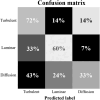Vortex-like vs. turbulent mixing of a Viscum album preparation affects crystalline structures formed in dried droplets
- PMID: 38839929
- PMCID: PMC11153723
- DOI: 10.1038/s41598-024-63797-z
Vortex-like vs. turbulent mixing of a Viscum album preparation affects crystalline structures formed in dried droplets
Abstract
Various types of motion introduced into a solution can affect, among other factors, the alignment and positioning of molecules, the agglomeration of large molecules, oxidation processes, and the production of microparticles and microbubbles. We employed turbulent mixing vs. laminar flow induced by a vortex vs. diffusion-based mixing during the production of Viscum album Quercus L. 10-3 following the guidelines for manufacturing homeopathic preparations. The differently mixed preparation variants were analyzed using the droplet evaporation method. The crystalline structures formed in dried droplets were photographed and analyzed using computer-supported image analysis and deep learning. Computer-supported evaluation and deep learning revealed that the patterns of the variant succussed under turbulence are characterized by lower complexity, whereas those obtained from the vortex-mixed variant are characterized by greater complexity compared to the diffusion-based mixed control variant. The droplet evaporation method could provide a relatively inexpensive means of testing the effects of liquid flow and serve as an alternative to currently used methods.
Keywords: Crystallization; Deep-learning; Droplet evaporation; Homeopathy; Turbulent and laminar flow.
© 2024. The Author(s).
Conflict of interest statement
The authors declare no competing interests.
Figures





Similar articles
-
Deep learning applied to analyze patterns from evaporated droplets of Viscum album extracts.Sci Rep. 2022 Sep 12;12(1):15332. doi: 10.1038/s41598-022-19217-1. Sci Rep. 2022. PMID: 36097279 Free PMC article.
-
Phenomenological Characterization of Low-Potency Homeopathic Preparations by Means of Pattern Formation in Evaporating Droplets.Homeopathy. 2019 May;108(2):108-120. doi: 10.1055/s-0038-1676325. Epub 2019 Jan 9. Homeopathy. 2019. PMID: 30625507
-
Blood motion: turbulent or laminar?Wiad Lek. 2017;70(2 pt 2):331-334. Wiad Lek. 2017. PMID: 29059653
-
Leidenfrost Effect-Induced Chaotic Vortex Flow for Efficient Mixing of Highly Viscous Droplets.Adv Mater. 2024 Oct;36(40):e2409192. doi: 10.1002/adma.202409192. Epub 2024 Aug 27. Adv Mater. 2024. PMID: 39188204
-
Production methods for nanodrug particles using the bottom-up approach.Adv Drug Deliv Rev. 2011 May 30;63(6):406-16. doi: 10.1016/j.addr.2011.03.011. Epub 2011 Mar 30. Adv Drug Deliv Rev. 2011. PMID: 21457742 Review.
Cited by
-
Diversity of Effects of Mechanical Influences on Living Systems and Aqueous Solutions.Int J Mol Sci. 2025 Jun 10;26(12):5556. doi: 10.3390/ijms26125556. Int J Mol Sci. 2025. PMID: 40565019 Free PMC article. Review.

